
“As he entered New York Harbor on the now slow-moving ship, Karl Rossmann, a seventeen-year-old youth who had been sent to America by his poor parents because a servant girl had seduced him and borne a child by him, saw the Statue of Liberty, which he had been observing for some time, as if in a sudden burst of sunlight. The arm with the sword now reached aloft, and about her figure blew the free winds.” So begins Franz Kafka’s fictional travelogue, Amerika: The Missing Person (1927). Kafka never set foot in America, so he may have really mistaken the Mother of Exiles’ gleaming torch for a weapon. We prefer to think he knew better. The sword symbolizes the ambivalence of America’s worldwide welcome – at once inviting and foreboding – and augurs Karl’s rejection and isolation in the New World as he learns that “one could not hope for pity here in this country…amid the indifferent faces on all sides.”
Plus ça change. Only in the nation’s folklore have the sea-washed, sunset gates opened to just anyone willing to accept the Creed and love America. Earnest belief and sincere emotion never secured a visa, spared a quarantine, or stamped a naturalization certificate. Today, the sword is no mere symbol to the millions of immigrants whose journey to America wends through sweltering desert heat, around armed patrols, and into the limbo of “illegality.” More of the world’s huddled masses make a new life here than anywhere else, but the land of rugged individualism still spurns those it deems unfit for the American Dream. Indeed, the country’s very first federal immigration policies not only banned Chinese immigrants altogether, but also “All idiots, insane persons, paupers or persons likely to become a public charge, persons suffering from a loathsome or a dangerous contagious disease, persons who have been convicted of a felony or other infamous crime or misdemeanor involving moral turpitude, polygamists, and also any person whose ticket or passage is paid for with the money of another or who is assisted by others to come.”
Why does America guard its shores at the point of the sword even as it illuminates them by the light of Liberty’s torch? As a once quiescent mass public asserts itself as a force in immigration politics and activists on both sides claim the mantle of popular legitimacy, this puzzle increasingly compels us to ask what a “nation of immigrants” wants from its immigration policy and why. In the brief essay that follows, we touch on several points:
- Americans are generally positive about immigration, and have become more so over time.
- They are, at the same time, quite ambivalent, taking on a pro-immigrant stance in some domains and an anti-immigrant stance in others.
- Peoples’ attitudes are responsive to the outside environment, which is to say that they are not set in stone but evolve over time.
- Americans are, at least in theory, persuadable based on different arguments, and different ways of framing the issue.
Public Opinion is Positive and Nuanced
A natural starting point for any inquiry on what the American public thinks about immigration is the granddaddy of all poll questions on the topic: “In your view, should immigration be kept at its present level, increased, or decreased?” First asked by Gallup in 1965 and at regular intervals since, responses to this question over the years (graphed in Figure 1, below) shows just how much Americans’ support for immigration has waxed and waned over the years.
The three most obvious features are:
- A general wariness in the two decades following 1965, with “decreasers” out-dueling “increasers” more than 3:1 throughout this period.
- A sharp spike in anti-immigrant sentiment in the mid-1990s, coinciding with a bipartisan policy push on crackdowns against illegal immigrants receiving government benefits.
- In the years and decades that followed, a gradual erosion of this hostility and commensurate growth among the “increased” group to the point that the lines actually crossed for the first time ever in the summer of 2020.
To gain some perspective on this apparent broad-scale liberalization, it is worth breaking out responses by party identification. Figure 2 below is based on the gold-standard American National Election Study (ANES), which has asked a question similar to Gallup’s, albeit over a shorter span. Instead of graphing individual responses to the question on separate trend lines, we show group mean (average) scores on each measure, ranging from 0 (“decreased”) to 1 (“increased”). Separate lines indicate trends for Democrats, Republicans, and independents.
Figure 2: Desired Immigration Level by Party Identification
Notes: Points are means, by party identification based on the first question in the survey's party identification battery.
Source: American National Election Studiers, Cumulative File and 2020 Time Series.
The figure confirms the nadir of pro-immigration sentiment in the early to mid-1990s and the gradual shift towards favorability since then. As with the Gallup series, the number of “increasers” surpassed the number of “decreasers” for the first time in 2020. But what we can see here that we could not in the earlier figure is that Democrats, Republicans, and independents largely agreed on these judgments up until 2008. After this point, the parties diverged rather sharply, and have continued to do so through the latest available period.
Recent polarization on immigration is nuanced and surprising. Fundamentally, despite President Trump’s reputation, it appears to be driven by Democrats, not Republicans. In the figure, notice that increased support for raising immigration levels is being driven more by a pro-immigrant shift among Democrats and independents. There is little evidence that Republicans are turning against immigration. To be sure, we see some of the latter between 2008 and 2016, but Republicans have evidently grown somewhat more sanguine in the four years between 2016 and 2020. Even at their nadir in 2016 – with Trump’s anti-immigrant rhetoric at or near its peak – Republicans were no more negative than they (or Democrats for that matter) had been in 1994.
Researchers tend to fixate on the “levels” question –How many immigrants should we admit?– because it is the one that pollsters have asked the most often and for the longest time. This tells us much of value, but it can’t tell us whether or not people are consistent across the wide variety of issues that touch on immigration or if they take a more nuanced view of matters. As it turns out, most voters are not monolithic. Rather, they take on a variety of issue positions – some restrictive, some expansionist – across immigration policy issues. We have explored this theme in depth elsewhere, but here for brevity’s sake, we offer a couple of exhibits from the 2020 round of the ANES – which contains a suite of immigration-related items, some tied to policy and others tied to general evaluations of immigrants and immigration.
Consider first those Americans (about 28% of the full ANES sample) who answer that “the number of immigrants coming from foreign countries who are permitted to come to the United States to live” should be either “decreased a little” or “decreased a lot.” Of these, almost half (49%) also support “providing a path to citizenship for unauthorized immigrants who obey the law, pay a fine, and pass security checks,” and almost two-thirds of them (64%) oppose “separating the children of detained immigrants, rather than keeping them with their parents in adult detention centers.”
At the same time, strong minorities of those who say that immigration is bad for the country don’t actually want to reduce it. Only 31% of people who disagree with the statement “immigrants are good for the American economy” want to cut immigration levels even “a little.” Only 37% of those agreeing that “America’s culture is generally harmed by immigrants” and 43% of those who agree that “immigrants increase crime rates in the United States” want to cut immigration. None of this is to suggest that these attitudes are completely disconnected. By and large nuanced, not single-mindedly restrictivist or expansionist, seems a more apt description of public opinion.
Public Opinion is Responsive
Despite the substantial shifts in public opinion on the “levels” question shown in Figures 1 and 2, not everyone agrees that people actually change their minds much on immigration, if at all. Some of this stems from different interpretations of these trends. For example, Kustov, et al. argue that “despite a few fluctuations and a seeming rise of positive attitudes among some voter groups over the last several years, the Gallup poll shows little change in the aggregate US immigration attitudes since 1966.”
This reading of the Gallup trend strikes us as excessively conservative by any reasonable standard. But we might still be skeptical that people change their minds for two reasons:
- Decades of literature connects immigration attitudes to deeply rooted and largely stable conceptions of social identity (chief among these, racial identity and ethnocentrism).
- Aggregate-level trends like those shown above might change because the nature of the population evolves, even if the individuals composing that population never change their minds. If, for example, we assume that ethnic minorities and immigrants to America are more favorable to immigration than whites and native-born Americans, then their growing numbers in the population since major liberalizing reforms in the 1960s might be at least partially responsible for the trends we observe.
There are two ways that we can test, in rigorous fashion, whether or not peoples’ minds change and, if so, in response to what. The first involves panel studies, which interview the same people twice or more. In our research, we’ve looked at this type of data: the level of immigration question in a General Social Survey (GSS, another top-quality survey) three-wave panel from 2006-08-10. It turns out that a person’s opinion about the level of immigration in any of the three waves is correlated with those in the others, which is not surprising. But these correlations are modest and not iron-clad. They are basically comparable to a number of other political and social issues.
More concretely, when we group respondents by whether they favored an increase of any kind, a decrease of any kind, or keeping things the same, about a third of respondents changed opinions in any two-year window. Fewer than half remained in the same broad category in all three waves. A mere 9% said they wanted to reduce immigration “a lot” all three times, and only about 1% wanted to increase it all three times.
These findings, which we’ve replicated to the best of our ability with more recent GSS (a set of 2020 reinterviews with respondents who’d originally been polled in either 2016 or 2018), suggest that the number of people taking on an entrenched and consistent “pro-” or “anti-immigrant” position is trivially small and that people move around quite a bit even over relatively short (2-year) intervals.
Of course, showing that people change their minds is very different from showing why. This is where our second method – survey experimentation – really comes into its own. In survey experiments, we give some people one story (or frame, or immigrant, or policy) to consider and other people another.
For example, to determine if people wanted to restrict immigrants for ethnocentric reasons, we might present two origin stories that are otherwise identical: one about a European immigrant from Sweden and another about an immigrant from Mexico. We would then assign people in our survey to see one story or the other and see how they respond. If we assign the stories at random, then we know that the only difference between the two groups – and hence the only possible cause of any difference in reaction – is the thing we changed, in this case the origin of the immigrant.
Taken together, survey experiments like this hypothetical example have shown that people can be moved, one way or the other, by all kinds of considerations. They react to cues signaling immigrants’ ethnicity, religious affiliation, and linguistic ability. They also respond heavily to partisan leaders’ position-taking, as well as arguments and frames that relate to core liberal values, such as equality, individualism and self-sufficiency, and the rule of law.
There is also evidence that information about immigrants learning English and integrating in their local communities can boost support for increasing immigration. So too can encouraging people to think about their own family’s immigrant heritage or to try to view the world through immigrants’ eyes.
Link to the Broader Information Environment
We have argued that people are nuanced in their views and that they appear to react very differently depending on which immigration issues are presented to them and how these issues are framed. While researchers have tried all kinds of different messages, prompts, and primes, we still know relatively little about the broader information environment that voters face: what social media content goes viral, what news stories legacy media push to prominence on their homepages or in primetime, and how political candidates advertise their positions on the issues as well as those of their opponents. Knowing more about how the information environment has evolved may give us clues about why the broader trends discussed earlier have evolved as they have. It would put boundaries on what kind of persuasion is possible.
For now, we can offer a few observations from a new analysis of a trove of campaign advertisements archived with the Wesleyan Media Project.
Here is what we know so far:
- Immigration plays a much stronger and much more nationalized role for Republican candidates than for Democrats, a pattern that has evolved since at least 2012.
- Regional patterns vary, but the balance of immigration-related ads almost everywhere in the country has been about restriction and control of immigration.
- The prevalence of ethnicity in these messages has held fairly steady, but the ads have more strenuously (on balance) emphasized law-breaking and illegality over the past decade.
That all of this has happened even while public opinion has become more accepting of immigrants presents something of a puzzle. Of course, we wouldn’t necessarily expect the two things to move in lockstep. Their connection is likely muddied by a number of things. For example, just because ads are playing doesn’t mean their content is persuasive. Candidates may also prefer efforts to mobilize their party’s base over persuading moderates and swing voters. As well, the prevalence of a given type of ad may have nothing to do with whether the candidate sponsoring them actually wins power. Finally, messaging might generate backlash among a candidate’s opponents or even alienation among likely voters if the tone is discordant enough.
Even so, one wonders whether infusing the ad environment with more messaging eliciting empathy with immigrants rather than fear or underlining their positive contribution to every aspect of society – things we know work in an experimental setting – would push public opinion even more firmly in an expansionist direction than it is already heading.
When it comes to the practical application of all this to politics, it seems clear that there is a small minority of the American public that is intensely hostile to immigration, motivated by some combination of economic anxiety, ethnocentrism, and concerns about law and order, immigrant assimilation, and so on. It also seems clear that political advertising presents modern immigration challenges in a way that is targeted to arouse anxiety among and ultimately motivate precisely this hostile set of people. Finally, we know that there is a much greater proportion of Americans that is, by and large, sanguine about immigration and at least potentially open-minded and willing to hear and vote based on more positive advertising. Whether or not advertising to this group would help political candidates win elections against broadsides from both directions is not something we can know with any certainty until more research can be done both in the lab and out in the real world.
Conclusion
Kafka’s armed Statue of Liberty is, wittingly or unwittingly, a nice metaphor for how much ambivalence about immigration we can find even in a self-styled “nation of immigrants.” But Pew’s polling shows that Americans appear increasingly willing to put down the sword and extend a hand.
Some might view the patterns and trends discussed here as an artifact of polling: why should we take an ambivalent and unstable public seriously? The answer is that there is order in what may seem like chaos: both change over time and variation across issues can be understood via careful attention to the kinds of psychological motivations brought to mind when people confront different policies, different immigrants, and different political contexts. The task of future researchers should be to better understand these root motivations in order to furnish advice on how to win elections and ultimately make better immigration policies.



